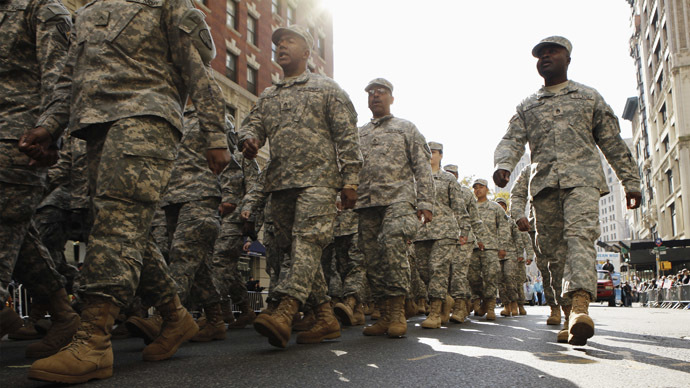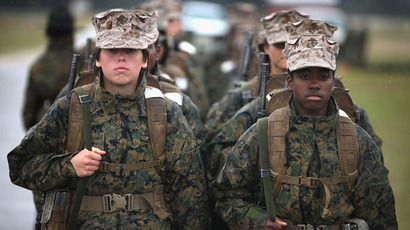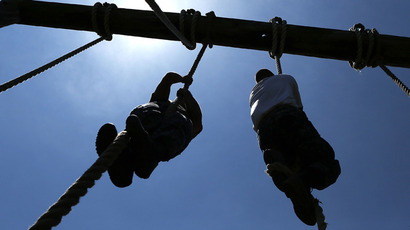Pentagon hunting serial predators in attempt to stop military sexual-assault epidemic

Taking a page of from sexual-assault prevention at the likes of college campuses, the Pentagon is putting new emphasis on finding serial predators throughout the military to address its own sex-crime epidemic.
The new focus marks a shift in approach by military officials, moving away from previous education campaigns that touted the “buddy system” and conservative dress that, at times, veered into victim blaming. The new method involves more aggressive investigation of suspects and repeat sex offenders.
“Understanding and accepting that [idea of serial perpetrators] make people understand that ‘he didn’t just drink a little too much,'" Maj. Gen. Margaret Woodward, who recently left her position as director of the Air Force’s Sexual Assault Prevention and Response Office, told the Monitor.
Research has shown that in some “semi-closed settings,” like college campuses, as many as 90 percent of sexual assaults come from serial predators, the Christian Science Monitor reported. Some Pentagon officials believe this theory could apply to military bases, and they are working with consulting psychologists who have worked on such studies.
“We think it tends to be, more often than we’ve believed before, ‘serial predators’ with more than one victim,” Woodward said. “If you get rid of just one of these predators, it’s pretty significant.”
Military law enforcement investigators are increasingly trained now to look into an assault suspect’s past for possible evidence or clues of habitual behavior. Previously, it was the victim’s behavior just prior to the assault that was put under the microscope.
“Obviously you’re going to investigate the incident, but we need to investigate the alleged offender, too,” Dr. David Lisak, a clinical psychologist working with the Pentagon to train prosecutors. “Are there any other victims?”
A higher quality of investigation into sexual assault cases is seen as a measure of success amid a systemic level of sex crime in the military. One recent Pentagon study showed that, within the ranks of the military, the number of service members who say they’ve been sexually assaulted during the last year amounted to roughly 26,000, though not all of those incidents were reported. According to data obtained by AP, there were more than 5,000 sexual assault reports during the 2013 fiscal year, which ended on Sept. 30. By contrast, there were 3,374 incidents reported in 2012. Some posit that increased reports are ultimately a good sign, given that it could indicate more victims are speaking up.
Nevertheless, the statistics add up to show a grim situation that the Pentagon has been accused of insufficiently addressing.
As internal processes to remedy the sexual assault epidemic have stalled, other sources have moved in to address concerns. The US Senate is expected to vote soon on the Military Justice Improvement Act, which would shift the decision to prosecute a crime punishable by one year or more in confinement – with some exceptions – to an independent body of military prosecutors. The bill would remove such cases from that chain of command, where crimes have been ignored in the past based on how the offenses would reflect on commanders.
The bill’s sponsor, Sen. Kirsten Gillibrand of New York, tweeted late Tuesday that 55 senators have publicly expressed support for the law. The bill would need 60 votes to pass.
An emphasis on better investigations has yielded progress already, according to some military officials.
“The biggest thing I’ve seen in our investigators is going from a bias toward investigating the victim,” said Col. S. Clinton Hinote, commander of the Eighth Fighter Wing at Kusan Air Force Base in South Korea. “If you go into the case with the mind-set that false allegations are rare but [that] perpetrators will perpetrate more than one crime – now that’s power. You may actually find incidents in the perpetrator’s past. It’s easier to prove five assaults than one.”
Investigations that reveal other victims “will bolster credibility in a ‘he said, she said’ scenario,” said the Air Force’s Woodward.
She noted that this can head off predators who are often meticulous about targeting those with discipline problems, knowing their credibility is not as strong.
“They may also prey upon people who have been assaulted before, as a result of what trauma can do to boundaries and vulnerabilities,” Woodward said. “Unfortunately, predators are very good.”
Others say the Pentagon must do more to highlight the consequences to perpetrators rather than promote assault-avoidance strategies.
“Up until three years ago, female troops going to Iraq were still getting rape whistles,” said Greg Jacob, policy director for the Service Women’s Action Network. “What hasn’t been addressed by [the Department of Defense] is that there is no training going on right now that highlights the cost of the crime, or what will happen to you if you decide to make this choice.”
According to the Pentagon, less than 20 percent of victims report a sexual assault within the military.














